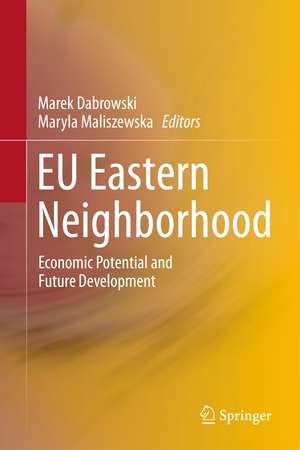EU Eastern Neighborhood: Economic Potential and Future Development
Editat de Marek Dabrowski, Maryla Maliszewskaen Limba Engleză Paperback – 13 dec 2014
| Toate formatele și edițiile | Preț | Express |
|---|---|---|
| Paperback (1) | 636.80 lei 6-8 săpt. | |
| Springer Berlin, Heidelberg – 13 dec 2014 | 636.80 lei 6-8 săpt. | |
| Hardback (1) | 643.00 lei 6-8 săpt. | |
| Springer Berlin, Heidelberg – 10 sep 2011 | 643.00 lei 6-8 săpt. |
Preț: 636.80 lei
Preț vechi: 749.19 lei
-15% Nou
Puncte Express: 955
Preț estimativ în valută:
121.87€ • 126.76$ • 100.61£
121.87€ • 126.76$ • 100.61£
Carte tipărită la comandă
Livrare economică 14-28 aprilie
Preluare comenzi: 021 569.72.76
Specificații
ISBN-13: 9783642439681
ISBN-10: 3642439683
Pagini: 220
Ilustrații: XX, 200 p.
Dimensiuni: 155 x 235 x 12 mm
Greutate: 0.32 kg
Ediția:2011
Editura: Springer Berlin, Heidelberg
Colecția Springer
Locul publicării:Berlin, Heidelberg, Germany
ISBN-10: 3642439683
Pagini: 220
Ilustrații: XX, 200 p.
Dimensiuni: 155 x 235 x 12 mm
Greutate: 0.32 kg
Ediția:2011
Editura: Springer Berlin, Heidelberg
Colecția Springer
Locul publicării:Berlin, Heidelberg, Germany
Public țintă
ResearchCuprins
The Development Gap Between the CIS and EU.- East-West Integration: A Geographical Economics Approach.- Deep Integration with the EU: Impact on Selected ENP Countries and Russia.- Energizing EU-FSU Relations: Challenges and Opportunities.- The Motives and Impediments to FDI in the CIS.- Global Ageing and the Macroeconomic Consequences of Migration from Neighborhood Countries to Europe.- Income and Distribution Effects of Migration and Remittances.- Institutional Convergence of the CIS Towards European Benchmarks.- Institutional Harmonization in the Context of EU Cooperation with Its Neighbors.- Technical Assistance to CIS Countries.- European Neighborhood Policy and Economic Reforms in the Eastern Neighborhood.- Economic Relations Between the EU and CIS.
Textul de pe ultima copertă
The selected papers in this volume were prepared under the research project on “EU Eastern Neighborhood: Economic Potential and Future Development (ENEPO)” funded by the EU Sixth Framework Program. They discuss the broad spectrum of development issues in the EU Eastern Neighborhood and economic relations between the enlarged EU and its Eastern neighbors in the former USSR. Individual chapters address areas of economic and social development, trade, energy, investment, migration, costs and benefits of economic reforms, development assistance and political economy of policy reforms. In particular, they examine interrelations and mutual synergies between trade liberalization, inflow of foreign investment, economic and institutional reforms and a reduction of income and development disparities. The publication thus closes an important knowledge gap in respect to the economic, social and institutional development of the CIS region and its economic relations with the EU.
Caracteristici
Represents the most comprehensive and updated study on economic and social development of the CIS region and its economic relations with the EU Provides the state-of-the-art to scientists Offers easily accessible information to policy-makers and other practitioners Makes useful recommendations for economic policy-making on international, European and national levels











